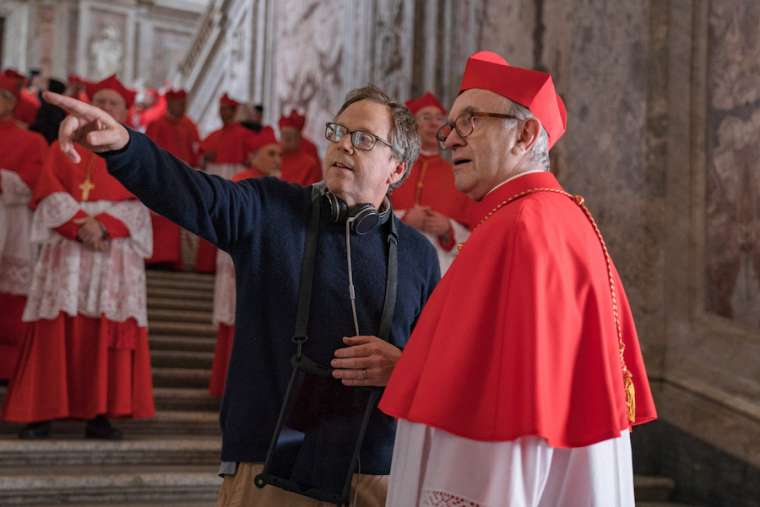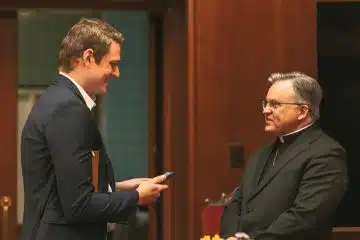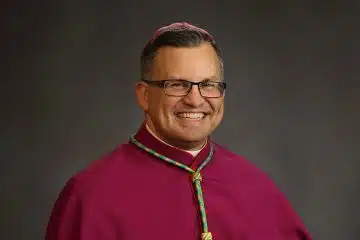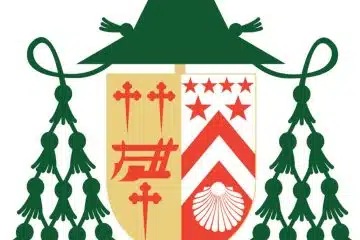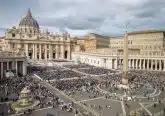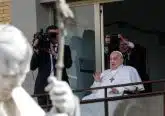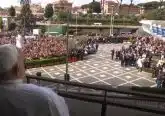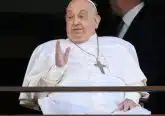Does ‘The Two Popes’ fairly represent Francis and Benedict? Critics say ‘no’
By Hannah Brockhaus
Vatican City, Dec 18, 2019 / 11:36 am (CNA).- A new Netflix production, “The Two Popes” centers on several imagined meetings between Pope Benedict XVI and Cardinal Jorge Bergoglio in the period between the 2005 conclave which elected Benedict and the 2013 conclave which elected Pope Francis.
Benedict XVI is played by Anthony Hopkins, and Cardinal Bergoglio, the future Pope Francis, is played by Jonathan Pryce.
While filmmakers say the movie is a work of fiction, the movie’s director also told CNA it represents his understanding of Pope Francis’ values. But critics emphasize the movie does not accurately represent Pope Benedict and Pope Francis, and instead reflects an ideological approach to the two men.
“The schematic casting of Pope Benedict XVI as a rigid reactionary and the future Pope Francis as a reforming revolutionary has less to do with the reality of either man than with the dramatist’s need for conflict and an ideological preference for the narrative of progressive liberation triumphing over hidebound traditionalism,” Deacon Steven Greydanus, a film critic and the founder of decentfilms.com, told CNA.
The thesis of “The Two Popes,” Greydanus said, “is that Benedict represents everything that was wrong with the Church of the past, while Francis is everything we need for the Church of tomorrow. Benedict is the vain, ambitious pope rejected by God, while Francis is the grounded, detached pastor chosen by God to lead us into the future.”
“Treating Benedict and Francis as emblems of antithetical camps, each opposed to everything the other stands for, is not only unjust to both popes, it perpetuates a polarized, reductionist model of conflict in the Church, and ultimately of the Church itself,” Greydanus noted.
“We should be talking about corruption versus real reform, secrecy versus communication, privilege versus accountability, tribalism versus solidarity,” he continued.
“Conservatism versus liberalism is such an exhausted and blinkered framework for tackling the very serious challenges facing the Church today,” Greydanus said.
The film’s director, Fernando Meirelles told CNA that he intended to draw a dichotomy between Benedict and Francis.
“When I first read the script, for me it was very clear: I had the good pope and the bad pope,” the director said.
“I was much more sympathetic toward Pope Francis, especially because I did not know much about Pope Benedict.”
On a political level, the director said the film presents Pope Francis’ “agenda.” According to Meirelles, this agenda includes the poor, “building bridges,” the “climate crisis,” and growing economic disparity.
“I admire him very much for this,” he said.
But critics and scholars said the film’s support for the director’s understanding of the pope’s agenda was heavy-handed and unrealistic.
Jorge Milan, a professor of audio-visual communication at the Pontifical University of the Holy Cross in Rome, told CNA in “The Two Popes,” “it was obvious that Ratzinger was on the conservative side: he’s boring, always very severe, sometimes even angry,” while Francis is portrayed as a progressive and sympathetic character.
Milan explained that “there is, in general, a polarization in the world, political polarization, so everything is put on the right or on the left.”
Enrique Fuster, who also teaches communications at the Pontifical University of the Holy Cross, said it is obvious Francis is supposed to be the “good pope” in the film, while Benedict is “not so good.”
That portrayal does “not do justice to Pope Benedict,” Fuster said.
The movie took its stereotypes much too far, Fuster said, with its weak and superficial treatment of Benedict’s involvement in the fight against sexual abuse in the Church.
Just one brief scene in the film treats the issue, with Benedict XVI “confessing” a past sin to Cardinal Bergoglio in such a way it insinuates the German pope knew about the sexually abusive Mexican priest and founder of the Legionaries of Christ, Marcial Maciel Degollado, but either did not act or waited too long to act.
This is both “false” and “unjust,” Fuster said.
In fact, as cardinal prefect of the Congregation for the Doctrine of the Faith, Joseph Ratzinger initiated the canonical investigation into Maciel, and as pope, removed him from priestly ministry in 2006. This is in addition to many other actions against abuse taken by Benedict both before and during his papacy.
Greydanus explained that “all fictional films, including those based on real people, take liberties with the facts.”
And because drama depends on conflict, “it’s not surprising that the film overstates the differences between Benedict and Francis.”
But those overstated differences include falsehoods, Greydanus said.
That Cardinal Ratzinger was ambitious for the papacy, as the film depicts, is also a well-known falsehood, Greydanus noted.
Even the film’s screenwriter, McCarten, in his nonfiction book “The Two Popes,” “lays out the evidence that the papacy was the last thing Ratzinger wanted, that for over a decade he had wanted to retire and devote himself to study and writing,” the critic said.
For his part, Milan took issue with the film’s portrayal of Benedict XVI as an angry and shouting person and as experiencing one of these moments of “lost connection” to God right before making the decision to resign the papacy.
Greydanus agreed. “Anyone who has benefitted from Ratzinger’s writing over the years knows how irenic he was in dialogue even with points of view he strongly disagreed with,” he said.
“The peevish, suspicious character in the film is a graceless caricature sometimes elevated by Hopkins’ subtle acting choices.”
Milan added that he would tell Catholics who might see “The Two Popes” that “they are going to watch a film with a lot of fiction.”
While he said the film was “interesting,” and ends on a constructive note, but “I wouldn’t say a Catholic should watch this film,” Milan added.
Meirelles, the director, told CNA as he researched for the film and as he watched Hopkins’ portrayal of Benedict, he came to realize Pope Francis and Pope Benedict XVI are “not so different as I thought in the beginning,” but that he still prefers “Pope Francis’ approach, really linked to the world, looking at what is around him.”
From Brazil, Meirelles is best known for co-directing “City of God,” the 2002 film based in a favela of Rio de Janeiro. He said he is Catholic but stopped attending Mass as a child.
It was not religion that drew him to accept the offer of directing the film, but politics, he stated; “I think [Pope Francis] understands the world in a way I agree.”
The director said that the film also has spiritual and personal elements to be considered.
“On a personal level, it’s a conversation between two men who don’t agree on most of their things, on most points. But they have to come to a common ground because they’re part of the same institution,” he described.
The spiritual element of the film, he said, is the idea that, even if you believe in God or another divine being, “at some point you lose connection.” Meirelles compared the Catholic concept of an intense period of spiritual desolation, sometimes called a “dark night of the soul,” with having an unfocused yoga session.
“This idea of not hearing God, of course it works for Catholics, but it works as well for anybody who has any beliefs,” he said.
The film mixes in real-life news footage from the conclaves and from historic events “to make it feel real,” but it is not a documentary or a “conventional biopic,” Meirelles said, explaining that the movie was supposed to be called “The Pope,” and to be centered on telling Francis’ story. But in the final months, the name was changed.
A large portion of “The Two Popes” is dedicated to flashbacks to significant moments in Pope Francis’ life in Buenos Aires, such as when he discerned a call to the priesthood and the Jesuits, and his action and inaction during the Argentina’s junta rule in the late ‘70s and early ‘80s.
There are moments of realism, such as showing Benedict’s affinity for Fanta. And the director pointed out some of the dialogue is adapted from real writings or speeches of the two popes, although quotes are used out of context and out of sync with the actual timeline.
Jonathan Pryce is a Welsh actor who plays Cardinal Jorge Bergoglio’s character in “The Two Popes.”
He told CNA he admires Francis’ politics as well. “Normally I would have gone, ‘do I really want to play a pope?’ but I wanted to play this pope with this script, with this director.”
Pryce said he grew up in the Protestant tradition.
“This was the first pope I felt was speaking to me in political terms,” he said. “Obviously the religious aspects I listened to and heard, but they were a given in a way. I liked the idea that he was a progressive and a socialist, which to me, socialism is a form of Christianity… Christian tenets are socialist tenets,” Pryce said.
Cardinal Peter Turkson, prefect of the Vatican’s Dicastery for the Promotion of Integral Human Development, saw the film at a screening Dec. 11.
He did not comment on the movie itself, when asked about it at an unrelated press conference Dec. 12, but called it an “interpretation.”
Turkson also said that while Pryce has a close physical resemblance to Cardinal Bergoglio, and pulled off his mannerisms well, he did not think Hopkins managed the same with Pope Benedict.
“The guy who played Benedict was a little too robust, too strong. If you see it, you’ll see that. Pope Benedict is feebler, softer spoken,” Turkson said.
A large advertisement for “The Two Popes” went up on scaffolding outside a Vatican-owned building Dec. 17. The building, which sits on the main street in front of St. Peter’s Square, is Vatican extraterritorial property and controlled by the Congregation for the Evangelization of Peoples, also called Propaganda Fide.
Though Turkson and other Vatican officials have seen the movie in private screenings, the Vatican has not publicly commented on it.
“The Two Popes” will stream on Netflix starting Dec. 20.
